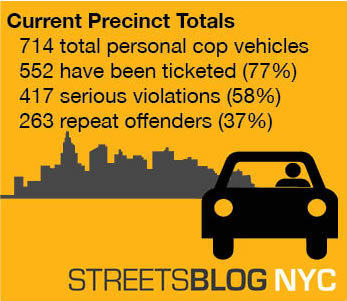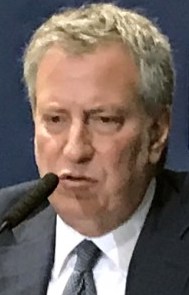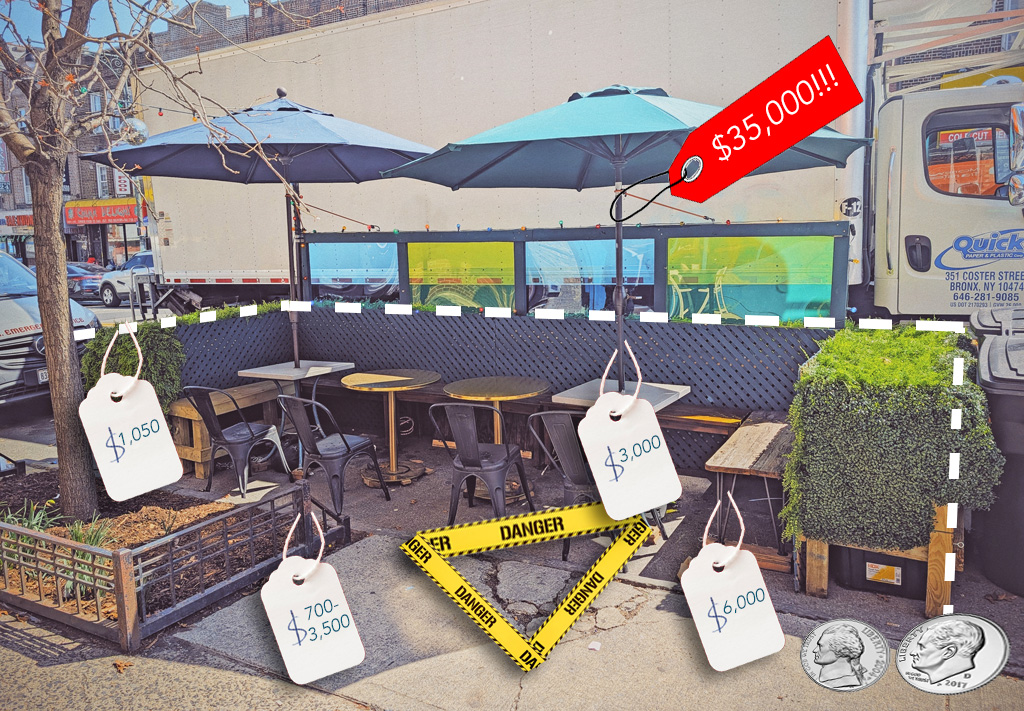Residents of Queens — and the principal of a major high school — are begging Mayor de Blasio to rid the streets of a recklessly driving NYPD cop who has blown past enforcement cameras 41 times, endangering pedestrians, cyclists, other motorists and the students whom the cameras are meant to protect.
Streetsblog reported this week that an officer at the 23rd Precinct in Manhattan has been slapped with 34 speeding tickets and seven red-light tickets — all issued by automated systems — since 2014. Eighteen of the speeding violations were captured on Queens Boulevard at 36th Street in Sunnyside, where the Department of Transportation has set up a camera. Ten more of the speeding tickets were issued by nearby cameras.
Locals are calling on the mayor to protect them.
"I don't feel safe," said Mark Ray, who works in the liquor store at the site of the speed camera system. "This guy needs to be suspended. He's so stupid. Eighteen tickets all at the same spot? There are kids here!"
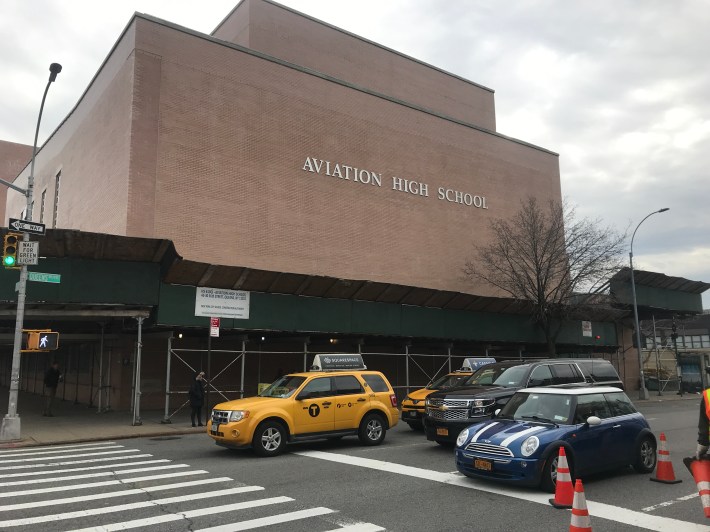
The kids to which Ray is referring pour into and out of Aviation High School, which is on the eastbound side of Queens Boulevard. Principal Steven Jackson told Streetsblog that he had seen our story on Twitter and was immediately concerned.
"We are always concerned about our students' safety," Jackson said. "I am definitely going to address this with the NYPD."
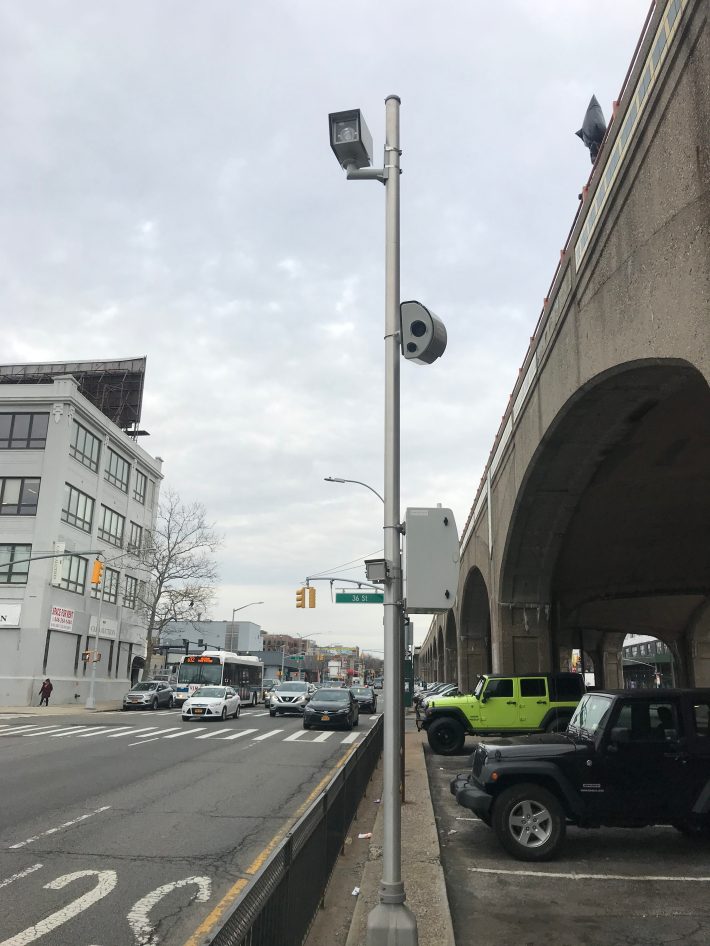
Since Streetsblog reported on the recidivist officer — who has 63 tickets overall — the website has discovered many more scofflaws who rack up a dozen or more tickets as drive to or from their station houses for work. The 108th Precinct in Long Island City, for example, has a cop whose personal vehicle has been hit with 31 tickets in all, including 18 camera tickets for speeding and two for running red lights.
In all, we have run the license plate numbers of 714 personal vehicles of NYPD officers and employees and found deep evidence that the people who are supposed to be protecting our communities are actually the very people from whom we all need to be protected.
Of all the driving records we checked through the Howsmydrivingny database:
- 552 officers' vehicles — or 77 percent — had at least one ticket.
- 417 vehicles — or 58 percent — had at least one serious moving violation, such as a red light or a speeding ticket.
- 263 vehicles — or 37 percent — had repeat serious violations.
The mayor declined to comment about the numbers, even though some of the recidivists would not even be allowed to drive under a pending bill by Council Member Brad Lander that would give the NYPD the right to impound any vehicle with five or more camera tickets in any 12-month period. Both cops mentioned in this story would have been in violation of that law.
“Everyone should be alarmed at the number and frequency of these violations. That’s why I’m a co-sponsor of Brad Lander’s bill to get reckless drivers off the road,” Council Member Jimmy Van Bramer said in a statement to Streetsblog, which reached out to Van Bramer because he represents the district that includes the 108th Precinct station house and the stretch of Queens Boulevard where the officer from the 23rd Precinct is so often caught.
Van Bramer and other politicians declined to criticize the NYPD, but activists and residents were livid after reading the Streetsblog account.
"Sharing the road with drivers like this NYPD officer is terrifying," said Laura Shepard, a Woodside resident and chairwoman of the Transportation Alternatives Queens Committee. "Those of us who walk and bike in Sunnyside are not safe on our streets while this driver is loose on the road. The city must use its power and devote resources to removing all drivers with egregious documented histories of reckless and dangerous behavior before they hurt or kill. We've already lost too many pedestrians and cyclists in Sunnyside and we don't want to lose any more."
Meanwhile, on the Upper East Side, residents are similarly terrified to know that the 23rd Precinct officer is frequently driving on their streets.
Wow, we’ve been on the reckless driving cop beat for a week now, but we haven’t seen anyone as bad as this @NYPD23Pct officer, who has 63 tix, including 34 for speeding and seven for red lights. @NYCMayor at long last can you get this guy off the road? @HowsMyDrivingNY ny:Epy9846 pic.twitter.com/eHNfTBhnFr
— Streetsblog New York (@StreetsblogNYC) March 12, 2019
"We expect that the first line of defense to this epidemic of traffic violence will be the mayor and the police department," said Hindy Schachter, whose husband was killed in a crash with a cyclist in 2014. "These individuals are charged to keep our streets safe. It is bad enough when some of them do not have adequate strategies for safety. It is outrageous when police officers actually perpetrate illegal actions that endanger all of us — but disproportionately senior citizens and the young. I say enough is more than enough. We need a police department that models how we expect all members of society to behave behind the wheel — not rogue officers who become part of the problem."
That's not how the mayor sees it, addressing the issue as a non-issue in an exchange on Monday with Streetsblog, which asked if he was worried that his plan to give more free parking to cops would unleash more reckless cops in our neighborhoods:
I disagree with that on its face. … The fact is these are our first responders, we expect them to show up no matter what. We expect them to stay when we need them to stay. A lot of them live quite far from where they work. It is important for everyone to drive safely. That’s what Vision Zero is all about and Vision Zero is filled with consequences and you are seeing more and more consequences each year. But it makes no sense to say, “OK, we know a lot or our uniform service officers have to drive to work and we are not going to give them a park.” That makes no sense. We are clearly very adamant that everyone has to follow the rules and there are consequences for those who don’t. But if we want to stop placard abuse we need to do something the root causes.
In a follow-up question, we asked the mayor about his use of the words “have to” in relation to commuting by car. Certainly, 51 percent of the police force lives outside the five boroughs, but the base salary of a New York City police officer is $85,292 after five years on the force, an income that is roughly $35,000 above the citywide median income. There is no way police officer “have to” drive to work because there is no way a police officer has to live outside the city on that salary.
Again, the mayor was irritated.
“I just said it in the beginning of my answer and I said it in the beginning of my answer last time,” he said, referring to a similar question Streetsblog had asked when the parking plan was first introduced. “Because a lot of them live very far away from the city, there’s not always great mass transit options, a lot of them have to stay all sorts of hours, a lot of them have to show up on short notice. It stands to reason.”
One man's reason is, apparently, another man's insanity.
After all, on Oct. 19, 2017, the mayor had positioned himself as the ultimate street safety advocate, telling reporters, "We love our city but let’s be clear, crossing the street in New York City should not be a harrowing experience. You shouldn’t feel unsafe crossing streets in your own neighborhood. We have to go after anyone who creates a threat to neighborhood residents."
Of course, the mayor was talking about electric bike riders, who have been the subject of a two-year-long NYPD crackdown.
But on cops who rack up 41 speeding and red-light tickets, the mayor remains silent.
"I’m at a point, honestly, where I don’t give a flying fuck what the mayor does," said Cristina Furlong of Make Queens Safer. "Crying to the mayor is not really an option for advocacy. Yes, the public shaming does occasionally work, but I’d like to see a lot of processes change so that there are guidelines and policies that change behavior."
Furlong called for passage of bills like Landers and a state bill by late State Senator Jose Peralta and Assembly Member Deborah Glick that would trigger a 60-day license suspension for any driver convicted of three school zone tickets in 18 months.
"If (or when) this cop mows somebody down, the bigger tragedy to me is going to be that the city didn’t do more to take reckless drivers off the roads before they hurt or killed someone," Furlong said. "As for the fact, he’s a cop, it only reaffirms for me that NYPD is absolutely clueless on training officers on the importance of traffic enforcement and it’s going to cost innocent people their lives."

